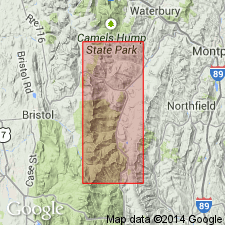
- Usage in publication:
-
- Lincoln Gap Member
- Modifications:
-
- Revised
- AAPG geologic province:
-
- New England province
Summary:
Granville Formation is revised to exclude graphitic schist and dolomite now assigned to the Battell Formation (rank raised) and to include carbonaceous albitic schist and super carbonaceous schist formerly assigned to the Hazens Notch Formation. The super carbonaceous schist is given the name Lincoln Gap Member, a name first proposed by Gordon (1927: Report of the State Geologist [unavailable for review]). The Lincoln Gap consists of black, rusty weathered quartz-muscovite-albite-graphite schist, and up to 5-cm-thick quartz-graphite-muscovite-albite quartzite. Schist is referred to as super carbonaceous because of abundant graphite, which occurs throughout the rock. Large continuous outcrops are not common as the rock is not very resistant. Three mapped bodies of the member are in gradational contact with the Mount Abraham Schist. These occur on Stark Mountain, on the Paradise ski trail at Mad River Glen Ski Area, and at the junction of the Jerusalem and Long Trails. Contact relationships in the Fayston Farms subdivision are not clear. Age according to map symbol is Cambrian.
Source: GNU records (USGS DDS-6; Reston GNULEX).
For more information, please contact Nancy Stamm, Geologic Names Committee Secretary.
Asterisk (*) indicates published by U.S. Geological Survey authors.
"No current usage" (†) implies that a name has been abandoned or has fallen into disuse. Former usage and, if known, replacement name given in parentheses ( ).
Slash (/) indicates name conflicts with nomenclatural guidelines (CSN, 1933; ACSN, 1961, 1970; NACSN, 1983, 2005, 2021). May be explained within brackets ([ ]).

